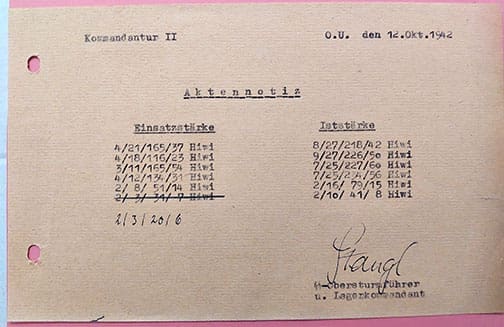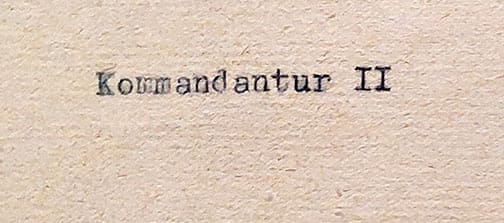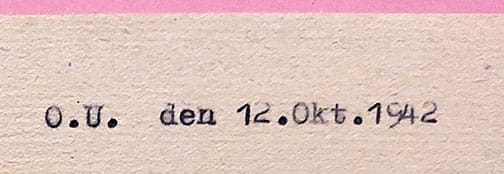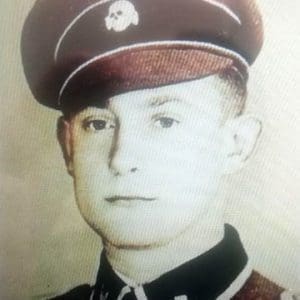Offered for sale is a
ORIGINAL 1942 DOCUMENT SIGNED BY TREBLINKA & SOBIBOR COMMANDANT
SS-HAUPTSTURMFüHRER FRANZ STANGL
HE PARTICIPATED IN THE T-4 EUTHANSIA PROGRAM, WAS COMMANDANT OF SOBIBOR AND TREBLINKA EXTERMINATION CAMPS AND HE WAS TRIED FOR THE DEATHS OF 1 MILLION PEOPLE
FULL MONEY BACK GUARANTEE FOR AUTHENTICITY
SS-Hauptsturmfűhrer Franz Stangl was an Austrian-born police officer and commandant of the Nazi extermination camps Sobibor and Treblinka. Stangl, an employee of the T-4 Euthanasia Program and a SS commander in Nazi Germany, became commandant of the camps during the Operation Reinhard phase of the Holocaust. He worked for Volkswagen do Brasil and was arrested in Brazil in 1967, extradited to West Germany and tried for the mass murder of one million people. In 1970, he was found guilty and sentenced to the maximum penalty, life imprisonment. He died of heart failure six months later.
Stangl became a member of the Austrian Nazi Party in 1931 when it was an illegal association for an Austrian police officer at that time. After the war, he denied having been a Nazi since 1931 and claimed that he had enrolled as member of the party only to avoid arrest following the Anschluss of Austria into Nazi Germany in May 1938. Records suggest that Stangl contributed to a Nazi aid fund, but he disavowed knowing about the intended party purpose of the fund. Stangl had Nazi Party number 6,370,447 and SS number 296,569. In 1935, Stangl was accepted into the Kriminalpolizei as a detective in the Austrian town of Wels. After Austria’s Anschluss, Stangl was assigned to the Schutzpolizei (which was taken over by the Gestapo) in Linz, where he was posted to the Jewish Bureau (German: Judenreferat). Stangl joined the SS in May 1938. He ultimately reached the rank of SS-Hauptsturmführer (Captain).
In early 1940, Stangl was instructed to report for work at the Public Service Foundation for Institutional Care (Gemeinnützige Stiftung für Anstaltspflege), a front organization of the T-4 Euthanasia Program.
Through a direct order from Reichsführer-SS Heinrich Himmler issued in November 1940, Stangl became the deputy office manager (Police Superintendent) of the T-4 Euthanasia Program at Hartheim Euthanasia Centre, and in late summer 1941 at Bernburg Euthanasia Centre, where people with mental and physical disabilities, as well as political prisoners, were sent to be killed.
At Hartheim, Stangl served under Christian Wirth as an assistant supervisor in charge of security. When Wirth was succeeded by Franz Reichleitner, Stangl stayed on as Reichleitner’s deputy. During his brief posting to Bernburg Euthanasia Centre Stangl reorganized the office at that T-4 facility. In March 1942, Stangl was given a choice to either return to the Linz Gestapo or be transferred to Lublin for work in Operation Reinhard. Stangl accepted the posting to Lublin in the General Government, where he would manage Operation Reinhard under Odilo Globočnik.
Stangl was appointed by Reichsführer-SS Heinrich Himmler to be the first commandant of Sobibor extermination camp. Stangl was Sobibor’s commandant from 28 April until the end of August 1942, at the rank of SS-Obersturmführer. He claimed that Odilo Globočnik initially suggested that Sobibor was merely a supply camp for the army and that the true nature of the camp became known to him only when he himself discovered a gas chamber hidden in the woods. Globočnik told him that if the Jews “were not working hard enough” he was fully permitted to kill them and that Globočnik would send “new ones”.
Stangl studied the camp operations and management of Bełżec, which had commenced extermination activity. He then accelerated the completion of Sobibor.[10] Around that time Stangl also had further dealings with Wirth, who was running extermination camps at Bełżec and Chelmno. Between 16 and 18 May 1942, Sobibor became fully operational.
On 28 August 1942, Odilo Globočnik ordered Stangl to become Kommandant at the newly opened but disorganized death camp, Treblinka, then under the incompetent command of Irmfried Eberl. Globočnik trusted that Stangl could restore order at Treblinka, since Stangl had a reputation as a highly competent administrator and people manager with an excellent grasp of detail.
Stangl assumed command of Treblinka on 1 September 1942. Stangl wanted his camp to look attractive, so he ordered the paths paved and flowers planted along the sides of Seidel Street, near camp headquarters and SS living quarters. Despite being directly responsible for the camp’s operations, Stangl said he limited his contact with Jewish prisoners as much as possible. Stangl rarely intervened with unusually cruel acts (other than gassing) perpetrated by his subordinate officers at the camp. He usually wore a white uniform and carried a whip, which caused prisoners to nickname him the “White Death”.
He claimed while in prison that his dedication had nothing to do with ideology or hatred of Jews. He said he matter-of-factly viewed the prisoners as material objects rather than people, including their extermination: “That was my profession. I enjoyed it. It fulfilled me. And yes, I was ambitious about that, I won’t deny it.” Stangl accepted and grew accustomed to the killings, perceiving prisoners not as humans but merely as “cargo” that must be destroyed. Stangl accepted the extermination of the Jews as a fact. At about this time, Stangl began drinking heavily. He is quoted as saying:
To tell the truth, one did become used to it…they were cargo. I think it started the day I first saw the Totenlager [extermination area] in Treblinka. I remember Wirth standing there, next to the pits full of black-blue corpses. It had nothing to do with humanity — it could not have. It was a mass — a mass of rotting flesh. Wirth said ‘What shall we do with this garbage?’ I think unconsciously that started me thinking of them as cargo…I rarely saw them as individuals. It was always a huge mass. I sometimes stood on the wall and saw them in the “tube” — they were naked, packed together, running, being driven with whips…
In September 1942, Stangl supervised the building of new, larger gas chambers to augment the existing gas chambers. The new gas chambers became operational in early autumn 1942. It is believed that these death chambers were capable of killing 3,000 people in two hours, and 12,000 to 15,000 victims easily every day, with a maximum capacity of 22,000 deaths in 24 hours.
In August 1943, along with Globočnik, Stangl was transferred to Trieste, where he helped organize the campaign against Yugoslav partisans and local Jews. Due to illness, he returned to Vienna in early 1945, where he served in the “Alpine Fortress” (Alpenfestung).
Although Stangl’s role in the mass murder of men, women and children was known to the Austrian authorities, a warrant for his arrest was not issued until 1961. Despite being registered under his real name at the Austrian consulate in São Paulo, it took another six years before he was tracked by Nazi hunter Simon Wiesenthal and arrested by Brazilian federal police on 28 February 1967. He never used an assumed name during his escape, and it is not clear why it took so long to apprehend him. After his extradition to West Germany by Brazilian authorities, he was tried for the deaths of around 1,000,000 people. He admitted to these killings but argued: “My conscience is clear. I was simply doing my duty…”[source: Wikipedia]
Franz Stangl was promoted to SS-Hauptsturmfűhrer in August of 1943. The document he signed still as SS-Obersturmfűhrer and Camp Commandant, meaning that this document originated either in the extermination camp Sobibor or the extermination camp Treblinka. The document, dated 12 October 1942, lists the number of inmates assigned to physical labor. Strong bold signature at the bottom right.
This item ships from one of our affiliates in Germany. It comes from a private collection and has never been offered for sale before. It was purchased directly out of a German foundation. The seller gives a full money back guarantee for the authenticity of the document and signature. Includes shipping worldwide.










Reviews
There are no reviews yet.